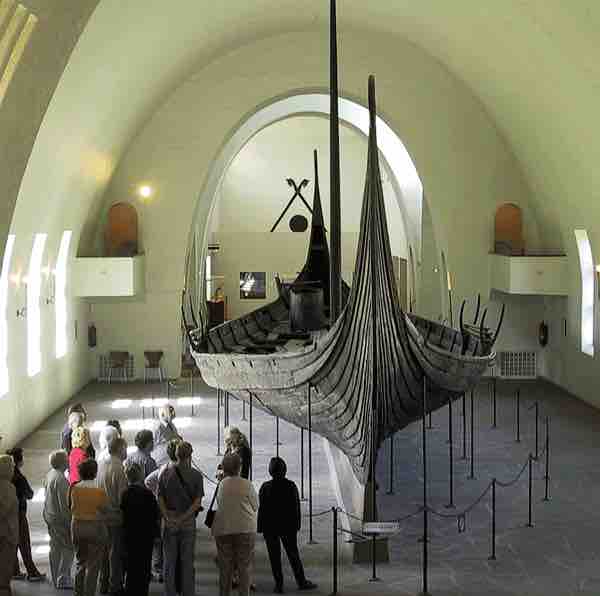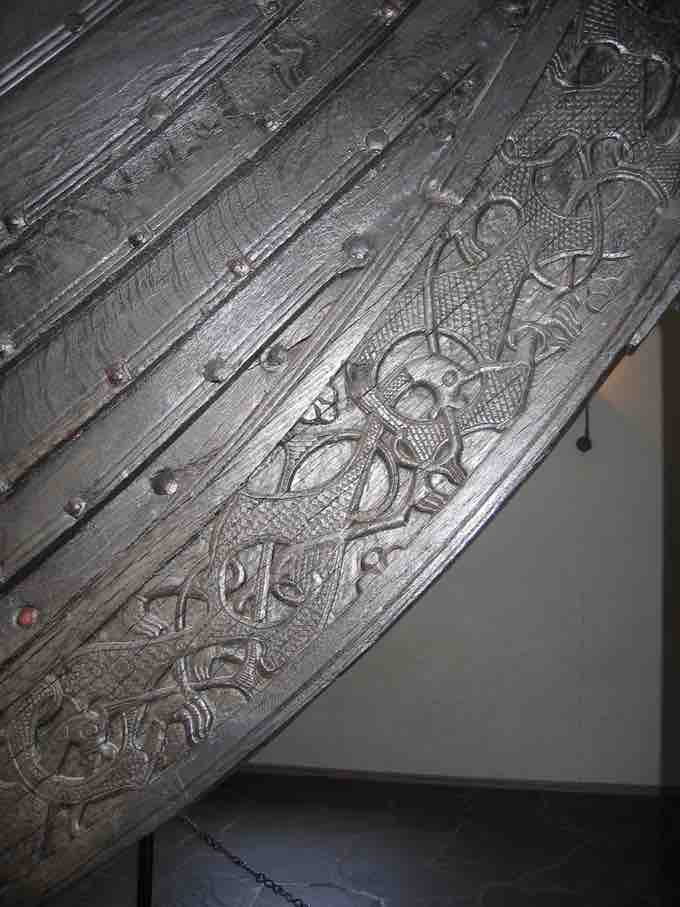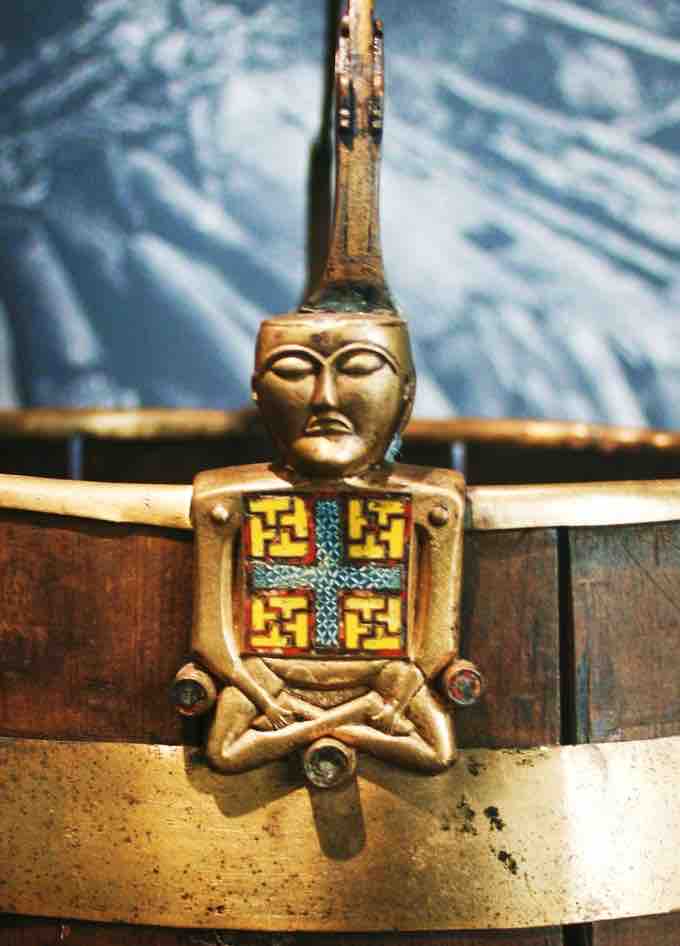Of Scandinavian descent, Norsemen are often called Vikings after their trading places from the Norwegian shoreline. Known as pre-Christian traders and pirates, Vikings used their great ships to invade European coasts, harbors, and river settlements on a seasonal basis. They created fast and seaworthy longships that served not only as warring and trading vessels, but also as media for artistic expression and individual design.
The great ships of the Vikings contain some of the major artworks left from this time. For instance, the Oseberg Bow demonstrates the Norse mastery of decorative wood carving and intricate inlay of metal. Likewise, the ship head post—representing a roaring beast—is five inches high with complicated surface ornamentation in the form of interwoven animals that twist and turn.
Osberg Ship Head Post
Animal head post found in the Oseberg ship. Viking Ship Museum, Oslo, Norway. The exact function of the head post is unknown.
Other examples of artistic design on Norse ships include the "King" or "Chieftain" vessels that were designated for the wealthier classes. Chieftain ships were distinguishable by the design of the bow of their vessel. This could involve various types of design such as bulls, dolphins, gold lions, drakes spewing fire out of their nose, human beings cast in gold and silver, and other unidentifiable animals cast in bronze metal. Typically, the sides of these vessels were decorated using bright colors and wood-carvings.
A Ship Burial
The Oseberg ship (Norwegian: Osebergskipet) is a well preserved Viking ship discovered in a large burial mound at the Oseberg farm near Tønsberg in Vestfold county, Norway. This ship is widely celebrated as one of the finest artistic and archaeological finds to have survived the Viking Age.

The Oseberg Ship
The Oseberg ship (Viking Ship Museum, Norway)
The Oseberg burial mound contained numerous grave goods and the remains of two female human skeletons. The ship's interment into its burial mound dates from 834 CE, but parts of the ship date from around 800 CE, and scholars believe that ship itself is older. The bow and stern of the ship are elaborately decorated with complex woodcarvings in the characteristic "gripping beast" style, also known as the Oseberg style. This style's primary features are the paws that grip the borders around it, neighboring beasts or parts of its own body. Although the Osberg style distinguishes early Viking art from previous trends, it is no longer generally accepted as an independent style. Although seaworthy, the ship is relatively frail. It is thought to have been used only for coastal voyages.

Oseberg Ship
This detail from the Oseberg ship demonstrates the elaborte woodcarving designs used as ornamentation on the bow and front of the ship.
The skeletons of two women were found in the Oseberg burial mound. It is not clear if one of the females was sacrificed to accompany the other in death. Regardless, the opulence of the burial rite and the grave goods suggests that this was a burial of very high status. For instance, one woman wore a very fine red wool dress of fabric woven in a lozenge twill pattern (a luxury commodity) and a fine white linen veil in a gauze weave. The other wore a plainer blue wool dress with a wool veil, showing some stratification in their social status. Neither woman wore anything entirely made of silk, although small silk strips were appliqued onto a tunic worn under the red dress.
The grave had been disturbed in antiquity, and many precious metals that were initially buried with Oseberg ship are therefore missing. Nevertheless, a great number of everyday items and artifacts were found during the early twentieth-century excavations of the site. These included four elaborately decorated sleighs, a four-wheel wooden cart, bedposts, wooden chests, and other richly decorated items. For instance, the so-called "Buddha bucket" is a well-known object from the Oseberg site that features a brass and cloisonné enamel ornament of a bucket (pail) handle in the shape of a figure sitting with crossed legs. The bucket itself is made from yew wood held together with brass strips, and the handle is attached to two anthropomorphic figures that are often compared to depictions of the Buddha in lotus posture (although any connection to Buddhism is most uncertain). Archaeologists also found more mundane items, such as agricultural and household tools, as well as a series of textiles that included woolen garments, imported silks, and narrow tapestries. The Oseberg burial is one of the few sources of Viking-age textiles, and the wooden cart is the only complete Viking-age cart found so far.

"Buddha Bucket"
The so-called "Buddha bucket" (Buddha-bøtte), brass and cloisonné enamel ornament of a bucket (pail) handle in the shape of a figure sitting with crossed legs.